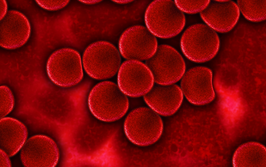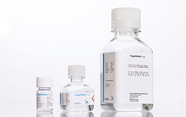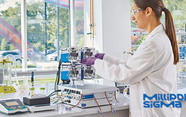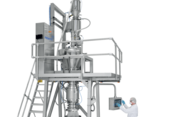Analysis and Characterization of GLP-1 Peptides
We ask an expert about the best practices for working with these complicated therapies.
Stephanie Vine | | 10 min read

Poor analytical work for GLP-1 peptides during drug development can have serious and far-reaching consequences. One of the most immediate risks is compromised patient safety. If impurities, such as truncated peptides, degradation products, or process related impurities, are not properly identified and controlled, they may lead to adverse immune responses, toxicity, or reduced therapeutic efficacy.
The enormous market for GLP-1 therapeutics is tempting many new biotechs to get involved with this space. However, GLP-1s are not easy products to work with. They are challenging to characterize and analyze because of their inherent complexity and the sophisticated modifications that are often introduced to enhance therapeutic performance. Getting your analytical work wrong can lead to product recalls, reputational damage, or legal action due to quality failures.
To find out more about the important role of analysis – and how analytical tech companies are reacting to the explosive interest in GLP-1s – we spoke with Matthew A. Lauber, Senior Director – Bioseparations, at Waters Corporations.
What activity are you seeing in the GLP-1 area and what trends interest you?
This space continues to evolve rapidly, with significant innovation beyond traditional GLP-1 receptor agonists. One of the most compelling trends is the shift toward multi-agonist sequences, such as GLP-1/GIP receptor agonists. Dual agonists have demonstrated superior weight loss and glycemic control, making them a key focus in next-generation drug development. Eli Lilly’s tirzepatide drugs – Mounjaro (tirzepatide) for diabetes treatment and Zepbound (tirzepatide) for weight loss treatment – outperform active comparators on lowering blood sugar and on weight loss benefits in several trials. Most recently, Novo Nordisk impressed investors with clinical results for amycretin, a GLP-1/amylin dual agonist that showed promising weight loss and metabolic control effects. This drug candidate could represent another wave of peptide drugs. Combined therapies are also on the horizon – this is where more than one peptide is included in a drug product formulation.
Another exciting trend is the push toward oral formulations. While injectable GLP-1 therapies dominate, recent advancements in formulation science are making oral delivery, such as Rybelsus (semaglutide), more viable. Permeation enhancers, nanoparticle carriers, or novel excipients are already being applied and are ripe for breakthroughs.
Overall, we’re witnessing a remarkable transformation in this field, with multi-agonists and new delivery formats paving the way for more effective and patient-friendly treatments.
What do you see as the biggest challenge in the analysis and characterization of GLP-1 peptides?
GLP-1 peptides can be challenging to work on because of their complexity, structural modifications, varying bioavailability, and conjugation chemistries, combined with challenging solubility and stability profiles. It is essential to know about each atom ahead of investigational new drug filings, during first-in-human clinical studies, upon seeking approval to go to market, and when completing batch release testing on a commercial product.
To give an example, let’s talk about the purity of a drug. GLP-1s can be produced by solid state synthesis or, in some more recent cases, by recombinant expression. When produced synthetically, a drug substance can contain truncated, incomplete peptide species. When produced recombinantly, they can contain host cell impurities. Whatever the manufacturing procedure, impurities must be controlled and carefully examined.
There are also other factors to consider. Peptide drugs are subject to chemical degradation reactions, such as oxidation and deamidation. Many GLP-1 therapeutics also incorporate chemical modifications, such as fatty acid conjugation to enhance half-life, improve receptor selectivity, and enable albumin binding. However, lipidation significantly alters its properties and considerations for how an analyst approaches an experiment.
How do impurities in synthetic peptides affect their overall efficacy and safety profile?
Impurities from incomplete synthesis and chemical degradation can affect efficacy, safety, and stability. Because of the importance of both characterizing and quantifying drug impurities, the FDA recently released product specific guidelines for some synthetic peptides on the market.
Aggregates can be very problematic. If the structure of a GLP-1 peptide drug changes, even just by one atom, there can potentially be a change in receptor binding, lower bioavailability, and diminished therapeutic potency. Some impurities can also trigger immunogenic responses, leading to adverse reactions or neutralizing antibodies that compromise drug effectiveness. This is often the case with aggregates, most especially covalently bonded multimers. Additionally, altered metabolism may produce toxic byproducts or affect clearance, increasing safety risks.
What kind of separation, identification, and analytical processes are important for GLP-1s?
Since the atomic composition and stability of a GLP-1 is so important, it is essential to establish analytical approaches that can precisely and accurately provide information on their exact molecular composition. This necessitates the use of chromatography and instrumentation that uniquely reports on sequence, chemical features, molecular weight, and size.
Advanced analytical techniques, such as HPLC and UHPLC, mass spectrometry, and light scattering, are essential for detecting, quantifying, and controlling impurities to ensure consistent drug performance and patient safety.
If I picked two chromatographic separation modes to focus on, it would be reversed-phase (RP) and size-exclusion chromatography (SEC). Each provide unique insights into peptide quality, purity, and stability. RP, commonly coupled with liquid chromatography-mass spectrometry (LC-MS), is used to assess peptide purity, detect impurities, and characterize modifications, such as oxidation, deamidation, and truncation. It relies on hydrophobic interactions to separate GLP-1 and its variants based on differences in polarity, making it ideal for detailed structural analysis and impurity profiling.
This approach is used in preclinical animal studies as a so-called inlet technique for quantitative dosing and metabolism studies. It is also used in a simpler capacity, with just a UV detector to confirm identity and test for impurities during batch release testing because it is particularly effective at resolving and detecting oxidation, deamidation, and incomplete sequences.
SEC, on the other hand, is essential for evaluating the aggregation and size distribution of GLP-1 peptides by separating molecules based on their hydrodynamic radius rather than chemical interactions. This technique helps assess formulation stability, detect higher-order structures, and monitor degradation pathways. Together, RP and SEC provide a comprehensive analytical approach, ensuring GLP-1 therapeutics meet stringent quality, safety, and efficacy requirements.
Is there a single preferred method for analyzing GLP-1s?
Separating and identifying; yes, maybe, but that’s not the whole story. The reversed phase separations noted above are incredibly powerful and important. However, they are inherently denaturing; thus, it is valuable to use additional separation mechanisms, such as SEC, to gather further insights. You will see too that there are different detectors to consider. UV peak detection is appropriate for quality control release testing, but components observed in the separation have probably been analyzed in detail by some form of molecular weight analysis.
When looking to detect a molecule or impurity’s molecular weight, there is, again, more than one way to go about an analysis. For example, mass spectrometry can be applied for accurate (down to 10 ppm mass accuracy) determination of a molecular weight. However, it requires the ionization and introduction of the analyte into the gas phase. While sensitive and incredibly specific for elucidation of molecular composition, there can sometimes be a loss of information about the sample as it is taken from its natural solution state into a vacuum (the gas phase).
Light scattering analyses can alternatively be applied, such as with the application of multiangle light scattering. When a sample is irradiated with light, the light will scatter. The larger the analyte, the more intense the scattered light. When used as a detector to measure the properties of eluting peaks, it becomes possible to calculate the mass of the detected component, so long as a concentration determining refractive index measurement is simultaneously made. LC-MALS measurements are complementary to mass spectrometry because they are based on the in-solution state of an analyte.
How is demand for GLP-1s changing around the world? Will this mean a change in approaches and technologies?
Global demand is surging, so we are continuing to see pharmaceutical innovation, expanding manufacturing capabilities, and some reshaping of global market competition. The US remains the dominant market, but Europe, China, and India are emerging as key players, with Indian pharmaceutical companies gearing up to produce cost-effective GLP-1 generics as patents expire. Regulatory approvals are accelerating, with India's regulatory body expected to clear domestically produced formulations soon.
Meanwhile, innovations in multi-receptor agonists, oral formulations, combined therapies and sustained-release injectables aim to improve patient use cases. Manufacturing bottlenecks and supply chain disruptions have brought major players to invest billions in production expansion, but India’s strength in peptide synthesis could make it a critical supplier of GLP-1 active pharmaceutical ingredients. Thus, the industry is anticipating a series of generics, and as the industry evolves, the key question remains whether generic competition will force global price reductions.
I predict that analytical approaches will adapt along the way too. Improvement in reproducibility and shortened turnaround times will make significant differences in drug development timelines and the risk of project delays forced by having to retest samples.
How do you foresee advancements in separation techniques influencing the future of peptide drug development, especially in the context of GLP-1 therapies?
Advances in separation techniques will make a difference to the industry because they will help developers improve safety, potency, stability, costs, and time-to-market. As multi-receptor GLP-1 therapies become more complex, increasingly higher resolution and increasingly more robust chromatographic techniques will become essential. Innovations in RP will facilitate faster runs and more careful examination of degradation, while improvements in denaturing size-exclusion chromatography (dSEC-MS) will make it possible to assess covalent aggregates more quickly and reliably.
Low-adsorption, high-performance surface columns have been developed that leverage charge-modified stationary phases to improve peptide separations and reduce secondary interactions. The combination of columns and instruments with high-performance surfaces (HPS) has proven to increase chromatographic performance in the analysis of GLP-1 agonists. For example, one HPS technology was shown to improve the chromatographic peak area, height, and tailing of synthetic peptides and impurities compared to traditional stainless-steel systems, and provide increases in chromatographic peak area of up to 28 percent, peak height of up to 51 percent, and reduction in peak tailing of 13 percent for a variety of GLP-1s tested.
When it comes to SEC, equally important progress is being made on the material science behind particle and column hardware technologies. For example, columns have been developed that utilize increasingly hydrophilic packing materials to enhance recovery and resolution, particularly for peptide-based biotherapeutics. These technologies, combined with advanced manufacturing, automation, and GxP compliant LC-MS methods, are driving more efficient, scalable, and high-purity production and testing of next-generation GLP-1 therapies.
Was the boom in GLP-1s expected? How are companies like Waters responding?
The boom in GLP-1 therapeutics was anticipated to some extent, but the speed and scale of their adoption in the last couple of years has probably exceeded almost everyone’s expectations. There are some trailblazers to recognize. The success of GLP-1 receptor agonists owes much to Richard DiMarchi and Lotte Bjerre Knudsen. Early in his career at Eli Lilly and Company, Richard Dimarchi observed the weight-loss effects of GLP-1 in diabetes patients. Later as a Department Chair at Indiana University Bloomington, DiMarchi’s research led to the development of “master key” molecules that targeted multiple receptors. DiMarchi’s work was influenced by Lottie Bjerre Knudsen’s foundational discoveries on GLP-1 stability and appetite-suppression mechanisms at Novo Nordisk, where she overcame hurdles to bring therapies such as liraglutide to market.
Funnily enough, it was about 20 years when I found myself in a graduate level journal club led by Professor DiMarchi. Like many others, I was exposed early on to this area of endocrinology research, so it is with great excitement that I can help advance its maturation into commercialized medicine, if not directly through pharmaceutical innovations, then through companies like Waters. We take our work very seriously and respond to industry and global needs with advanced analytical technologies to ensure precise characterization, careful stability assessments, accurate drug metabolism and pharmacokinetic studies, and reliable purity testing. As demand continues to rise, robust analytical tools will be critical to maintaining drug safety, efficacy, and regulatory compliance.

Making great scientific magazines isn’t just about delivering knowledge and high quality content; it’s also about packaging these in the right words to ensure that someone is truly inspired by a topic. My passion is ensuring that our authors’ expertise is presented as a seamless and enjoyable reading experience, whether in print, in digital or on social media. I’ve spent fourteen years writing and editing features for scientific and manufacturing publications, and in making this content engaging and accessible without sacrificing its scientific integrity. There is nothing better than a magazine with great content that feels great to read.



















